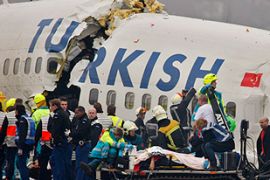Probe begins into Turkish jet crash
Data recorders recovered as investigators examine wreckage at Amsterdam airport.

Boeing, the world’s second-biggest commercial-jet maker, sent a team to provide technical support to the Dutch Safety Board, which dispatched five people to the site.
The US National Transportation Safety Board also sent a team to assist the probe.
Fred Sanders of the Dutch board said it could take weeks before further information was released.
“We will have an official finding probably in about a year, but we should be able to give an interim finding within weeks,” he said.
Possible causes
| In video | ||
|
|
Investigators are set to explore a wide range of possible causes of the crash, ranging from weather-related factors such as wind shear or icing, to fuel starvation, navigational errors or pilot fatigue.
Nazanine Moshiri, Al Jazeera’s correspondent at Schiphol airport, said it was “the fact that the plane crashed into a muddy ploughed field that saved many lives”.
She said the soft ground cushioned the impact and probably stopped a fire from starting.
“The plane was trying to land but it seems it missed the runway and crashed next to a busy motorway,” she said.
Chris Yates, an aviation expert with Jane’s Defence Weekly magazine, said that it was possible that the jet could have been struck by birds; as was the case in the New York Hudson river crash in January.
“Bird strike is always a potential problem … as we saw with the Hudson crash, bird strike can happen at any point,” Yates said.
“When you get birds in the two engines you lose power and all sorts of horrible things can happen.”
Catastropic impact
The jetliner, which was carrying 135 people, broke into three pieces after hitting the ground around 3km short of the runway. The aircraft’s fuselage tore in two near the cockpit and the tail was ripped off.
Despite the catastrophic impact, the wreckage did not burn and scores of people walked away.
|
“It was a miracle there were not more casualties.” Binali Yildirim, Turkish Transport Minister |
Binali Yildirim, the Turkish transport minister, said: “The fact that the plane landed on a soft surface and that there was no fire helped keep the number of fatalities low.
“It was a miracle there were not more casualties.”
However, Michel Bezuijen, mayor of the Haarlemmermeer municipality, where the airport is located, said: “Of the 50 people injured, 25 were seriously injured.”
Authorities said the death toll could have been far higher if the jet had not gone down in mud.
Also, because it had reached its destination, the aircraft would have used up most of its fuel, lessening the chances of a fuel-driven fire.
Turkish Airlines had a poor air safety history in the 1970s but has improved markedly.
The company’s last big accident was in 2003 when one of its aircraft missed the runway in heavy fog in the southeastern Turkish city of Diyarbakir and 75 people were killed.
